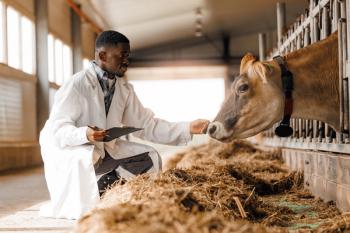
Incentives to enter large-animal practice on rise
There are many new incentives to encourage veterinary students to consider careers in large-animal medicine or to work in underserved rural areas.
NATIONAL REPORT — It may be true that the wheels of change turn slowly, but turn they do.
That appears to be the case when it comes to encouraging more veterinary students to consider careers in food-animal practice, whether working for federal government agencies that protect the nation's food supply or becoming private practitioners in underserved rural areas.
Shortages in both areas have long been acknowledged. In recent years only about 200 graduates a year, or fewer than 10 percent of each graduating class, have demonstrated interest in large-animal medicine.
But lately there seems to be a spate of new incentives, including some from industry, and more emphasis on existing ones to attract students.
And many are taking advantage of them.
"If you're interested in working with farm animals or in public health, this could be a very good time to go to veterinary school," Dr. James Cook, past president of the American Veterinary Medical Association (AVMA), said during a recent speech.
"Many states, the federal government and even the AVMA have begun college-loan repayment programs to entice young veterinarians into this field."
He was referring to some $4.8 million available for that purpose under the National Veterinary Medical Services Act (NVMSA), which should start offering loan repayments this fall. The program has been on the books since 2003, but was stifled by lack of funding.
While specific terms are yet to be worked out, it is hoped that new DVMs could earn up to $25,000 a year the first two years and then $35,000 in their third and fourth years by serving in rural food-supply veterinary medicine.
Many state governments, including Ohio, Nebraska, New Hampshire, Washington, Wyoming and Kansas offer their own student-debt assistance plans, and other states are considering them.
A number of private programs are also being developed. The AVMA and its charitable arm, the American Veterinary Medical Foundation, are developing a loan-repayment program offering $20,000 to $30,000 a year over four years for young practitioners willing to work in rural areas.
Pfizer Animal Health launched an externship program earlier this year for students interested in large-animal medicine.
The program has an emphasis on producing more cattle veterinarians. It is helping 100 externship recipients in 27 veterinary schools with an interest in that area.
Pfizer's program works with the schools in two ways: It places first- and second-year students with beef- and dairy-cattle practitioners for four weeks. It provides a stipend and identifies veterinary clinics willing to mentor students.
For universities that already have an externship program, the company provides matching funds.
Veterinary schools offer various incentive programs, too, to interest more students in large-animal medicine.
One example is the Early Veterinary Student Bovine Experience Program at the University of California-Davis School of Veterinary Medicine, aimed at increasing the number of graduates working with dairy and beef cattle.
It has 19 students spending five weeks this summer on dairies and with veterinarians to gain an inside view of that side of the profession.
"This gives students an excellent opportunity to work in an area of food-animal practice under the mentorship of either a food-animal veterinarian or a producer," says John Angelos, program director.
Students typically begin by working five weeks at a dairy or in a beef-cattle operation to see the issues producers face in production settings.
Those interested may follow up next summer with a more advanced five-week assignment with a veterinarian. At clinics and on field calls, the student will work directly with the veterinarian to observe cases, help with diagnostics and vaccination programs and take part in discussions between the veterinarian and clients in analyzing herd health and concerns.
The goal is to give the student practical career advice, business tips and insight into working conditions and lifestyles of rural practitioners.
Of this year's participants, nine are returning from last year to work with DVMs. Most assignments are in California, but some are headed to Texas, Nevada, Oregon and North Dakota.
Each student receives a $2,500 scholarship partly funded by Pfizer Animal Health.
Earlier this year, the AVMA improved the food-supply section of its Web site,
Newsletter
From exam room tips to practice management insights, get trusted veterinary news delivered straight to your inbox—subscribe to dvm360.






